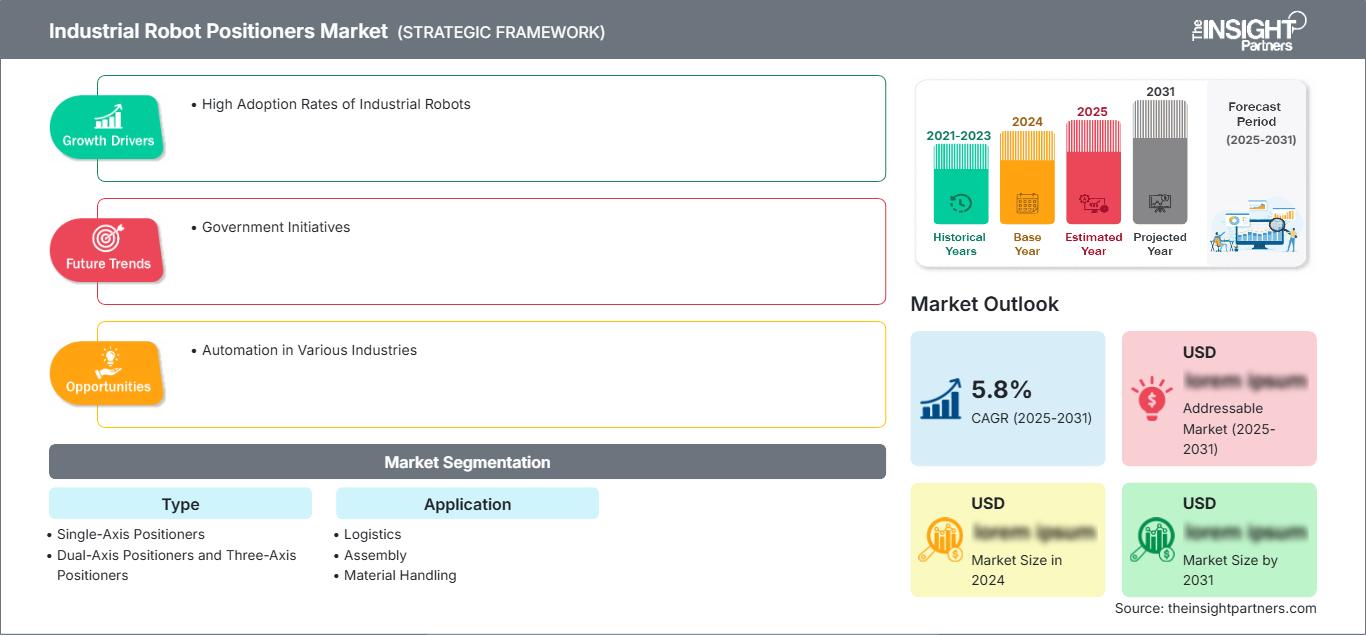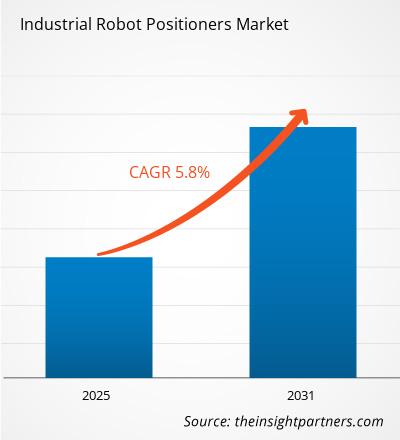Der Markt für industrielle Roboterpositionierer wird zwischen 2023 und 2031 voraussichtlich eine durchschnittliche jährliche Wachstumsrate (CAGR) von 5,8 % verzeichnen. Die Automatisierung in verschiedenen Branchen wird voraussichtlich ein wichtiger Trend auf dem Markt bleiben.
Marktanalyse für industrielle Roboterpositionierer
- Hohe Akzeptanzraten, getrieben durch Produktivitäts- und Genauigkeitsvorteile, führen zu einer hohen Nachfrage nach Industrierobotern, was das Marktwachstum ankurbelt. Darüber hinaus treibt die zunehmende Automatisierung in Branchen wie der Öl- und Gasindustrie, der Chemieindustrie und Wärmekraftwerken die Nachfrage nach digitalen Positionierern weiter an und eröffnet sowohl bestehenden als auch neuen Akteuren in der Branche neue Möglichkeiten.
- Es gibt branchenübergreifend viele neue Möglichkeiten zur Effizienzsteigerung auf dem Markt, und die Initiativen der Regierungen verschiedener Länder dürften einen starken Boom in der Fertigung auslösen und damit einen unmittelbaren Bedarf an effizienteren Betriebsabläufen in Fabriken und Industrien schaffen.
Marktübersicht für Industrieroboter-Positionierer
- Industrieroboter-Positionierer, auch Werkstückpositionierer genannt, sind programmierbare Mechanismen mit einer oder mehreren Achsen, die gemeinsam mit einem Industrieroboter laufen und diesem erweiterte Fähigkeiten verleihen. Zu den verschiedenen verfügbaren Positionierern gehören Drehtische, die das Werkstück um eine Achse drehen und für besseren Zugang oder bessere Beweglichkeit an Wänden, Schienen oder anderen Oberflächen montiert werden können.
- Sie bilden die Grundlage für die Roboterautomatisierung in vielen Anwendungen, einschließlich des Schweißens, da sie die Genauigkeit, Wiederholbarkeit und Qualität der Gesamtproduktion verbessern. Sie können auch kleine Teile in großen Stückzahlen oder große Teile in kleinen Stückzahlen verarbeiten; außerdem verfügen sie über eine hohe Wiederholgenauigkeit, sodass sie stets präzise Schweißarbeiten durchführen können.
Passen Sie diesen Bericht Ihren Anforderungen an
Sie erhalten kostenlos Anpassungen an jedem Bericht, einschließlich Teilen dieses Berichts oder einer Analyse auf Länderebene, eines Excel-Datenpakets sowie tolle Angebote und Rabatte für Start-ups und Universitäten.
Markt für Industrieroboter-Positionierer: Strategische Einblicke

- Holen Sie sich die wichtigsten Markttrends aus diesem Bericht.Dieses KOSTENLOSE Beispiel umfasst Datenanalysen, die von Markttrends bis hin zu Schätzungen und Prognosen reichen.
Markttreiber und -chancen für industrielle Roboterpositionierer Hohe Akzeptanzraten für Industrieroboter
Sie erhalten kostenlos Anpassungen an jedem Bericht, einschließlich Teilen dieses Berichts oder einer Analyse auf Länderebene, eines Excel-Datenpakets sowie tolle Angebote und Rabatte für Start-ups und Universitäten.
Markt für Industrieroboter-Positionierer: Strategische Einblicke

- Holen Sie sich die wichtigsten Markttrends aus diesem Bericht.Dieses KOSTENLOSE Beispiel umfasst Datenanalysen, die von Markttrends bis hin zu Schätzungen und Prognosen reichen.
- Einer der Haupttreiber des Marktes für industrielle Roboterpositionierer ist die zunehmende Akzeptanz von Industrierobotern. Dies ist hauptsächlich auf die Produktivitäts- und Genauigkeitssteigerungen durch den Einsatz von Industrierobotern zurückzuführen. Da Industrieroboter weiterhin eine gute Wachstumsrate aufweisen, ist davon auszugehen, dass die Nachfrage nach industriellen Roboterpositionierern entsprechend steigen und im Prognosezeitraum zu hohen Umsätzen führen wird. Dieser Trend spiegelt sich in der allmählichen, aber anhaltenden Verlagerung von manuellen zu automatisierten Prozessen wider, bei denen der Industrieroboter eine zentrale Rolle bei der Verbesserung der Genauigkeit von Arbeitsabläufen und der Effizienz spielt und gleichzeitig die Betriebsabläufe vereinfacht.
- Die Nachfrage nach Industrierobotern ist in Branchen wie der Automobilindustrie, der Fertigung, der Logistik und der Lagerhaltung aufgrund des Bedarfs zur Lösung des Arbeitskräftemangels und zur effizienten Herstellung hochwertiger Produkte zu verzeichnen. Auch die Integration von Software für maschinelles Lernen und Sicherheitsfunktionen in End-of-Arm-Tools (EOAT) wird die technologische Komplexität von Industrierobotern weiter erhöhen; es zeigt daher einen anhaltend positiven Trend auf dem Markt für Positioniergeräte für Industrieroboter.
- Die Automobilindustrie selbst gehört zu den größten Anwendern von Robotertechnologie und nutzt Robotik in großem Umfang aus Sicherheits- und Produktivitätsgründen, was das Wachstum auf dem Markt für Positioniergeräte für Industrieroboter fördert. Der zunehmende Einsatz von Industrierobotern und die damit verbundene Nachfrage nach Positionierern in der Kategorie Industrieroboter waren wichtige treibende Variablen, die das Wachstum und die Entwicklung dieses Marktes prägen, mit Umsatz- und Marktwachstumschancen im Prognosezeitraum.
Regierungsinitiativen
- Regierungsinitiativen, wie die der indischen Regierung, sollen Berichten zufolge einen starken Boom in der Produktion auslösen; dies wiederum schafft einen unmittelbaren Bedarf, die Betriebseffizienz in Fabriken und Industrien zu erhöhen, um die Nachfrage zu decken.
- Die indische Regierung hat mehrere Initiativen zur Förderung dieses Wachstums im Fertigungssektor, wie etwa die National Manufacturing Policy, die darauf abzielt, den Anteil des Fertigungssektors am BIP bis 2031 auf 25 Prozent zu erhöhen, und das PLI-Programm, das zur Entwicklung des Kernfertigungssektors auf Augenhöhe mit globalen Standards eingeführt wurde.
- Darüber hinaus soll die Initiative SAMARTH Udyog Bharat 4.0 des Ministeriums für Schwerindustrie und öffentliche Unternehmen der indischen Regierung dazu beitragen, die Wettbewerbsposition des Landes in der Fertigungsindustrie zu verbessern und, was noch wichtiger ist, zu Spillover-Vorteilen auf dem Investitionsgütermarkt beizutragen. Diese Initiativen der Regierung zur Schaffung eines günstigen Umfelds für das Wachstum der Produktion würden eine erhöhte Nachfrage nach Betriebseffizienz und Automatisierung bedeuten und somit neue Möglichkeiten für Positioniergeräte für Industrieroboter eröffnen.
Marktsegmentierung für Positioniergeräte für Industrieroboter
Schlüsselsegmente, die zur Ableitung der Marktanalyse für Positioniergeräte für Industrieroboter beigetragen haben, sind Typ und Anwendung.
- Nach Typ ist der Markt in Einachs-, Zweiachs- und Dreiachs-Positioniergeräte unterteilt.
- In Bezug auf die Anwendung ist der Markt in Logistik, Montage, Materialhandhabung und andere segmentiert.
Marktanteilsanalyse für Positioniergeräte für Industrieroboter nach Geografie
- Der Marktbericht für Positioniergeräte für Industrieroboter umfasst eine detaillierte Analyse von fünf großen geografischen Regionen, einschließlich der aktuellen und historischen Marktgröße und Prognosen für 2021 bis 2031, und deckt Nordamerika, Europa, den asiatisch-pazifischen Raum (APAC), den Nahen Osten und Afrika (MEA) sowie Süd- und Mittelamerika ab.
- Jede Region ist weiter in die jeweiligen Länder unterteilt. Dieser Bericht bietet Analysen und Prognosen für über 18 Länder und deckt die Marktdynamik für mechanische Tastaturen ab, wie z. B. Treiber, Trends und Chancen, die die Märkte auf regionaler Ebene beeinflussen.
- Der Bericht umfasst außerdem eine PEST-Analyse, die die Untersuchung der wichtigsten Faktoren umfasst, die den Markt für Industrieroboter-Positionierer in diesen Regionen beeinflussen.
Industrieroboter-PositioniererRegionale Einblicke in den Markt für industrielle Roboterpositionierer
Die Analysten von The Insight Partners haben die regionalen Trends und Faktoren, die den Markt für Industrieroboter-Positionierer im Prognosezeitraum beeinflussen, ausführlich erläutert. In diesem Abschnitt werden auch die Marktsegmente und die geografische Lage von Industrieroboter-Positionierern in Nordamerika, Europa, im asiatisch-pazifischen Raum, im Nahen Osten und Afrika sowie in Süd- und Mittelamerika erörtert.
Umfang des Marktberichts zu industriellen Roboterpositionierern
| Berichtsattribut | Einzelheiten |
|---|---|
| Marktgröße in 2024 | US$ XX million |
| Marktgröße nach 2031 | US$ XX Million |
| Globale CAGR (2025 - 2031) | 5.8% |
| Historische Daten | 2021-2023 |
| Prognosezeitraum | 2025-2031 |
| Abgedeckte Segmente |
By Typ
|
| Abgedeckte Regionen und Länder | Nordamerika
|
| Marktführer und wichtige Unternehmensprofile |
|
Marktdichte von Industrieroboter-Positionierern: Auswirkungen auf die Geschäftsdynamik verstehen
Der Markt für Industrieroboter-Positionierer wächst rasant. Dies wird durch die steigende Endverbrauchernachfrage aufgrund veränderter Verbraucherpräferenzen, technologischer Fortschritte und eines stärkeren Bewusstseins für die Produktvorteile vorangetrieben. Mit der steigenden Nachfrage erweitern Unternehmen ihr Angebot, entwickeln Innovationen, um den Verbraucherbedürfnissen gerecht zu werden, und nutzen neue Trends, was das Marktwachstum weiter ankurbelt.

- Holen Sie sich die Markt für Industrieroboter-Positionierer Übersicht der wichtigsten Akteure
Der Markt für Industrieroboter-Positionierer wird durch die Erhebung qualitativer und quantitativer Daten aus Primär- und Sekundärforschung bewertet, die wichtige Unternehmenspublikationen, Verbandsdaten und Datenbanken umfasst. Einige der Entwicklungen auf dem Markt für Industrieroboter-Positionierer sind nachfolgend aufgeführt:
- THG Automation hat einen revolutionären Rotationsschweißpositionierer vorgestellt, der speziell für den Markt des kollaborativen Schweißens entwickelt wurde und eine Vielzahl von Vorteilen gegenüber herkömmlichen Positionierern bietet.
(Quelle: THG Automation, Pressemitteilung, Juni 2023)
- Pemamek hat eine neue agile und kompakte Roboterschweißstation, PEMA Skytrack, auf den Markt gebracht. Die Lösung umfasst einen 2-achsigen PEMA Skyhook Pro-Positionierer, einen 6-achsigen Yaskawa-Roboterschweißarm und eine lineare Roboterschiene. PEMA Skytrack setzt mit seiner Handhabungskapazität von 2 Tonnen und einer Roboterverfahrlänge von 2600 mm (102 Zoll) einen neuen Standard für kompakte Roboterstationen.
(Quelle: Pemamek, Unternehmenswebsite, Dezember 2022)
Marktbericht zu industriellen Roboterpositionierern – Abdeckung und Ergebnisse
Der Bericht „Marktgröße und Prognose für industrielle Roboterpositionierer (2021–2031)“ bietet eine detaillierte Analyse des Marktes und deckt die folgenden Bereiche ab:
- Marktgröße und Prognose für industrielle Roboterpositionierer auf globaler, regionaler und Länderebene für alle wichtigen Marktsegmente, die im Rahmen abgedeckt sind
- Industrieroboter stellen Markttrends sowie Marktdynamiken wie Treiber, Einschränkungen und wichtige Chancen dar
- Detaillierte PEST/Porters Five Forces- und SWOT-Analyse
- Marktanalyse für industrielle Roboterpositionierer mit Abdeckung wichtiger Markttrends, globaler und regionaler Rahmenbedingungen, wichtiger Akteure, Vorschriften und aktuelle Marktentwicklungen
- Branchenlandschaft und Wettbewerbsanalyse mit Marktkonzentration, Heatmap-Analyse, prominenten Akteuren und aktuellen Entwicklungen auf dem Markt für Positioniersysteme für Industrieroboter
- Detaillierte Unternehmensprofile
- Historische Analyse (2 Jahre), Basisjahr, Prognose (7 Jahre) mit CAGR
- PEST- und SWOT-Analyse
- Marktgröße Wert/Volumen – Global, Regional, Land
- Branchen- und Wettbewerbslandschaft
- Excel-Datensatz
Aktuelle Berichte
Erfahrungsberichte
Grund zum Kauf
- Fundierte Entscheidungsfindung
- Marktdynamik verstehen
- Wettbewerbsanalyse
- Kundeneinblicke
- Marktprognosen
- Risikominimierung
- Strategische Planung
- Investitionsbegründung
- Identifizierung neuer Märkte
- Verbesserung von Marketingstrategien
- Steigerung der Betriebseffizienz
- Anpassung an regulatorische Trends




















 Kostenlose Probe anfordern für - Markt für Industrieroboter-Positionierer
Kostenlose Probe anfordern für - Markt für Industrieroboter-Positionierer